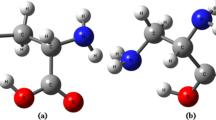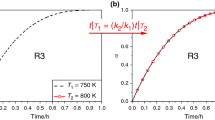Abstract
In order to describe the thermodynamic behavior of methane, argon, and nitrogen in the so-called “natural-gas region,” namely, from 270 to 350 K at pressures up to 30 MPa as accurate as possible with equations of a very simple form, new equations of state for these three substances have been developed. These equations are in the form of a fundamental equation in the dimensionless Helmholtz energy; for calculating the pressure or the density, the corresponding equations explicit in pressure are also given. The residual parts of the Helmholtz function representing the behavior of the real gas contain 12 fitted coefficients for methane, 8 for argon, and 7 for nitrogen. The thermodynamic relations between the Helmholtz energy and the most important thermodynamic properties and the needed derivatives of the equations are explicitly given; to assist the user there is also a table with values for computer-program verification. The uncertainties when calculating the density ρ, the speed of sound w, the isobaric specific heat capacity c p, and the isochoric specific heat capacity c v are estimated as follows. For all three substances it is Δρ/ρ≤±0.02 % for p≤ 12 MPa and Δρ/ρ ≤ ±0.05% for higher pressures. For methane it is Δw/w≤±0.02% for p≤10 MPa and Δw/w≤+-0.1% for higher pressures; for argon it is Δw/w≲-0.1 % for p≤ 7 MPa, Δw/w≤±0.3 % for 7 <p≤30 MPa; and for nitrogen it is Δw/w≤±0.1% for p≤1.5 MPa and Δw/w±0.5% for higher pressures. For all three substances it is Δc p/c p≤±1 % and ΔC v/C v≤±1 % in the entire range.
Similar content being viewed by others
Abbreviations
- A :
-
Specific Helmholtz energy
- a, b, n :
-
Adjustable coefficients
- C p :
-
Isobaric specific heat capacity
- C v :
-
Isochoric specific heat capacity
- d, t :
-
Exponents
- h :
-
Specific enthalpy
- I :
-
Maximum value of the serial number
- i, j :
-
Serial numbers
- p :
-
Pressure
- R :
-
Specific gas constant
- R m :
-
Molar (universal) gas constant
- s :
-
Specific entropy
- T :
-
Absolute temperature
- u :
-
Internal energy
- w :
-
Speed of sound
- z=p/(ρRT) :
-
Compression factor
- Δ :
-
Difference in a quantity
- δ=ρ/ρ c :
-
Reduced density
- ∂ :
-
Partial differential
- μ :
-
Joule-Thomson coefficient
- ρ :
-
Mass density
- τ=T c/T:
-
Inverse reduced temperature
- Γ=A/(RT) :
-
Dimensionless Helmholtz energy
- o:
-
Ideal-gas property
- r:
-
Residual
- c:
-
At the critical point
- expt:
-
Experimental
- calc:
-
Calculated
- i, j :
-
Serial numbers
- o:
-
Reference state
References
Preston-Thomas, Metrologia 27:3 (1990).
J. R. de Laeter and K. G. Heumann, J. Phys. Chem. Ref. Data 20:1313 (1991).
U. Setzmann and W. Wagner, J. Phys. Chem. Ref. Data 20:1061 (1991).
R. Gilgen, R. Kleinrahm, and W. Wagner, in preparation.
R. T Jacobsen, R. B. Stewart, and M. Jahangiri, J. Phys. Chem. Ref. Data 15:735 (1986).
E. R. Cohen and B. N. Taylor, The 1986 Adjustment of the Fundamental Physical Constants, CODATA Bulletin No. 63, Comm. Data Sci. Tech., Int. Council Sci. Unions (Pergamon Press, Oxford, 1986).
S. Angus, K. M. de Reuck, and B. Armstrong, International Thermodynamic Tables of the Fluid State-6 (Pergamon Press, Oxford, 1979).
U. Setzmann and W. Wagner, Int. J. Thermophys. 10:1103 (1989).
H. W. Schamp, E. A. Mason, A. C. B. Richardson, and A. Altman, Phys. Fluids 1:329 (1958).
D. R. Douslin, R. H. Harrison, R. T. Moore, and F. P. McCullough, J. Chem. Eng. Data 9:358 (1964).
D. R. Roe, Thermodynamic Properties of Gases and Gas Mixtures at Low Temperatures and High Pressures, Ph.D. thesis (University of London, London, 1972).
R. D. Goodwin and R. Prydz, J. Res. Natl. Bur. Stand. Sec. A76:81 (1972).
R. D. Goodwin, The Thermophysical Properties of Methane, from 90 to 500 K at Pressures up to 700 bar, Natl. Bur. Stand. (US), Tech. Note 653 1974.
N. J. Trappeniers, R. Wassenaar, and J. C. Abels, Physica 98A:289 (1979). Erratum: Physica 100A:660 (1980).
J. Mollerup, J. Chem. Thermodyn. 17:489 (1985).
H. J. Achtermann, T. K. Bose, H. Rögener, and J. M. St-Arnaud, Int. J. Thermophys. 7:709 (1986).
R. Kleinrahm, W. Duschek, W. Wagner, and M. Jaeschke, J. Chem. Thermodyn. 20:621 (1988).
N. Pieperbeck, R. Kleinrahm, W. Wagner, and M. Jaeschke, J. Chem. Thermodyn. 23:175 (1991).
M. Jaeschke and M. Hinze, Ermittlung des Realgasverhaltens von Methan und Stickstoff und deren Gemische im Temperaturbereich von 270 K bis 353 K und Drücken bis 30 MPa, Fort.-Ber. VDI-Z. Reihe 3, Heft 262 (VDI-Verlag, Düsseldorf, 1991).
H. J. Achtermann, J. Hong, W. Wagner, and A. Pruss, J. Chem. Eng. Data 37:414 (1992).
G. C. Straty, Cryogenics 14:367 (1974).
B. E. Gammon and D. R. Douslin, J. Chem. Phys. 64:203 (1976).
A. Sivaraman and B. E. Gammon, Speed-of-Sound Measurements in Natural Gas Fluids, GRI Report 86/0043 (1986).
A. R. H. Goodwin, Thermophysical Properties from the Speed of Sound, Ph.D. thesis (University of London, London, 1988).
W. Lemming, Experimentelle Bestimmung akustischer und thermischer Virialkoeffzienten von Arbeitsstoffen der Energietechnik, Fort.-Ber. VDI-Z. Reihe 19, Nr. 32 (VDI-Verlag, Düsseldorf, 1989).
J. P. M. Trusler and M. Zarari, J. Chem. Thermodyn. 24:973 (1992).
B. A. Younglove, J. Res. Natl. Bur. Stand. (US) 78:401 (1974).
R. Budenholzer, B. Sage, and W. Lacey, Ind. Eng. Chem. 31:369 (1939).
M. L. Jones, D. T. Mage, R. C. Faulkner, and D. L. Katz, Chem Eng. Proc. Symp. Ser. 59:52 (1963).
G. P. Baxter and H. W. Starkweather, Proc. Natl. Acad. Sci. USA 14:57 (1928).
A. Michels, H. Wijker, and H. K. Wijker, Physica 15:627 (1949).
P. W. Townsend, Pressure-Volume-Temperature Relationships of Binary Gaseous Mixtures, Ph.D. thesis (Columbia University, New York, 1956).
R. W. CrainJr. and R. E. Sonntag, Adv. Cryog. Eng. 11:379 (1966).
A. L. Blancett, K. R. Hall, and F. B. Canfield, Physica 47:75 (1970).
V. A. Rabinovich, L. A. Tokina, and V. M. Berezin, High Temp. 8:745 (1970).
V. M. Cheng, Measurements on the Dense-Fluid Equation of State and the Melting Parameters of Argon, Methane and Nitrogen at High Pressures, Ph.D. thesis (Princeton University, Princeton, NJ, 1972).
J. Hoinkis, Untersuchungen zum thermischen Verhalten von binären Gasmischungen mit Kohlendioxid, Dissertation (Technische Hochschule Karlsruhe, 1989.
X. Y. Guo, R. Kleinrahm, and W. Wagner, Experimentelle Untersuchung der systematischen Meßfehler von Betriebsdichteaufnehmern für Erdgas-Meßstrecken-Teil 1: Meßergebnisse für Stickstoff, Kohlendioxid, Argon, Neon, Ethan und Ethen, Research Report (Lehrstuhl für Thermodynamik, Ruhr-Universität Bochum, 1992.
A. Lacam and J. Noury, Comptes Rendus 236:362 (1953).
A. Lacam and J. Noury, Comptes Rendus 236:2039 (1953).
A. Lacam, J. Recherch. CNRS 34:25 (1956).
A. van Itterbeek, W. van Dael, and W. Grevendonk, Physica 25:640 (1959).
S. S. Lestz, J. Chem. Phys. 38:2830 (1963).
O. F. Susekov, Russ. J. Phys. Chem. 46:1115 (1972).
A. Michels, R. J. Lunbeck, and G. J. Wolkers, Physica 15:689 (1949).
R. B. Stewart and R. T Jacobsen, J. Phys. Chem. Ref. Data 18:639 (1989).
J. T. R. Watson and K. M. de Reuck, Survey of the Available Accurate p-p-T Data for Nitrogen in the Range 0 to 70°C and 0 to 30 MPa, Report produced for EUROMET Project P89/202 1992.
A. Michels, H. Wouters, and J. de Boer, Physica 1:587 (1934).
J. Otto, A. Michels, and H. Wouters, Physik. Z. 35:97 (1934).
A. Michels, H. Wouters, and J. de Boer, Physica 3:585 (1936).
R. Boden, Prüfung von Betriebsdichtegebern mit Ekofisk-Erdgas über Dichtebestimmung nach dem Wägeverfahren, Research Report (Ruhrgas AG, Essen, 1984).
W. Duschek, R. Kleinrahm, W. Wagner, and M. Jaeschke, J. Chem. Thermodyn. 20:1069 (1988).
F. F. Voronov, L. L. Pitaevskaya, and A. V. Bilevich, Russ. J. Phys. Chem. 43:321 (1969).
B. A. Younglove and R. D. McCarty, J. Chem. Thermodyn. 12:1121 (1980).
E. J. Workman, Phys. Rev. 37:1345 (1931).
Author information
Authors and Affiliations
Additional information
Paper dedicated to Professor Joseph Kestin.
Rights and permissions
About this article
Cite this article
Wagner, W., Span, R. Special Equations of State for Methane, Argon, and Nitrogen for the Temperature Range from 270 to 350 K at Pressures up to 30 MPa. Int J Thermophys 14, 699–725 (1993). https://doi.org/10.1007/BF00502103
Received:
Issue Date:
DOI: https://doi.org/10.1007/BF00502103




